Air compressors are widely used in various industries and for personal use, powering a wide range of pneumatic tools and applications.
Air compressor tank is an essential component to consider when understanding air compressors.
The choice of tank size should be based on your specific requirements, balancing the need for extended tool runtime with the physical constraints of space and maneuverability.
Air Compressor Tank Guide

- Air Compressor Tank Guide
- Understanding Air Compressor Tank Sizes:
- Different Types Of Air Compressor Tanks:
- Calculating The Right Tank Size For Your Projects:
- Calculate The Tank Size Based On CFM Requirements And PSI Needs:
- How To Clean Air Compressor Tank – 5 Easy Steps:
- Analyze The Differences Between Vertical And Horizontal Tank Models:
- Factors To Consider When Choosing A Tank Size:
- How Big Of An Air Compressor Tank Do I Need?
- How To Fill Paintball Tank With Air Compressor?
- How To Fill HPA Tank With Air Compressor?
- How To Prevent HPA Tanks From Exploding?
- How To Fill Co2 Tank With Air Compressor?
- How Many Gallon Air Compressor To Paint A Car?
- How Many Gallon Air Compressor To Blow Out Sprinklers?
- How Many Gallon Air Compressor Do I Need?
- Does Air Compressor Tank Size Matter?
- What Are The Different Sizes Of Air Compressor Tanks?
- What Is The Standard Size Of An Air Compressor?
- Air Compressor Sizing Excel:
- Air Compressor Tank Thickness:
- Air Compressor Tank Specification:
- Air Compressor Tank CFM Calculator:
- How To Size An Air Compressor Tank
- Air Compressor Tank Safety Guide:
- Air Compressor Tank Dimensions:
- Does Air Compressor Tank Size Matter?
- Can An Air Compressor Be Too Big?
- Benefits Of A Larger Tank:
- Benefits Of A Smaller Tank:
- Is It Bad To Leave An Air Compressor Tank Full?
- Can A Pressure Tank Be Too Big?
- Is A Bigger Air Compressor Tank Better?
- How To Replace An Air Compressor Tank?
- Air Compressor Tank Design Calculation
- Frequently Asked Questions
The tank size, measured in gallons, generally determines the runtime of your pneumatic tool before the compressor needs to turn back on to refill with air.
Larger tanks usually allow for longer runtime but they also necessitate more space and can be more challenging to move.
In This Article:
• Understanding Air Compressor Tank Sizes
• Different Types Of Air Compressor Tanks
• Calculating The Right Tank Size For Your Projects
• Calculate The Tank Size Based On CFM Requirements And PSI Needs
• How To Clean Air Compressor Tank?
• Analyze The Differences Between Vertical And Horizontal Tank Models
• Factors To Consider When Choosing A Tank Size
• How Big Of An Air Compressor Tank Do I Need?
• How To Fill Paintball Tank With Air Compressor?
• How To Fill HPA Tank With Air Compressor?
• How To Prevent HPA Tanks From Exploding?
• How To Fill Co2 Tank With Air Compressor?
• How Many Gallon Air Compressor To Paint A Car?
• How Many Gallon Air Compressor To Blow Out Sprinklers?
• How Many Gallon Air Compressor Do I Need?
• Does Air Compressor Tank Size Matter?
• What Are The Different Sizes Of Air Compressor Tanks?
• What Is The Standard Size Of An Air Compressor?
• Air Compressor Tank Thickness
• Air Compressor Tank Specification
• Air Compressor Tank CFM Calculator
• How To Size An Air Compressor Tank?
• Air Compressor Tank Safety Guide
• Air Compressor Tank Dimensions
• Does Air Compressor Tank Size Matter?
• Can An Air Compressor Be Too Big?
• Is It Bad To Leave An Air Compressor Tank Full?
• Can A Pressure Tank Be Too Big?
• Is A Bigger Air Compressor Tank Better?
• How To Replace An Air Compressor Tank?
• Air Compressor Tank Design Calculation
• Q&A
Read In Detail About All Tank Size Air Compressors:
Understanding Air Compressor Tank Sizes:
Air compressor tank size refers to the volume of the reservoir in the air compressor that holds compressed air.
It’s typically measured in gallons or liters, and it plays a crucial role in how an air compressor operates. The tank size can determine the amount of air and the pressure it can store.
Larger tanks can store more air, allowing for longer operational periods before the compressor motor has to kick back in and refill the tank.
Conversely, smaller tanks are quicker to refill but may have to refill more often if the air demand is high.
Therefore, determining the appropriate air compressor tank size will depend on the specific requirements of your air tools and the tasks at hand.
Different Types Of Air Compressor Tanks:
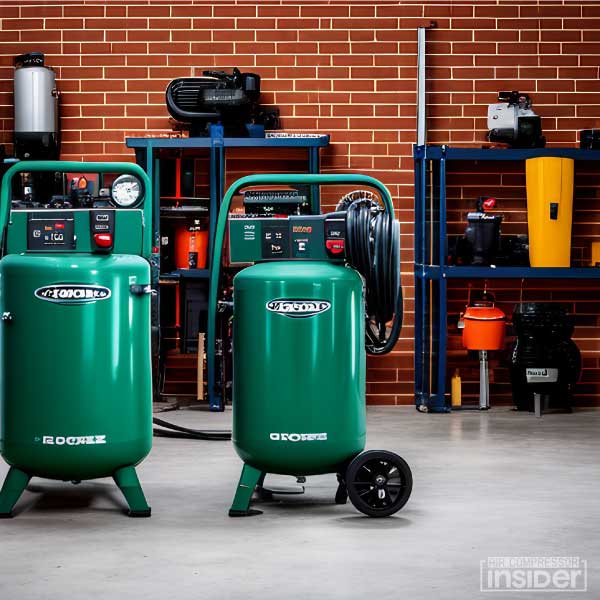
Air compressor tanks can be categorized broadly into three types:
1. Single-Stage
2. Two-Stage
3. Multi-Stage.
1. Single-Stage Tanks:
Single-stage tanks are the most common type of air compressor tanks, ideal for home use and light commercial applications. These tanks employ a single piston that compresses and delivers air at the same pressure level in a single action.
2. Two-Stage Tanks:
These tanks use two pistons to compress and deliver air. The air is first compressed by one piston at a lower pressure and then transferred to a smaller tank where the second piston compresses it further at a higher pressure. Two-stage tanks are commonly used in industrial and heavy commercial applications.
3. Multi-Stage Tanks:
Multi-stage tanks consist of multiple pistons operating in different tanks to compress and deliver air at varying pressure levels. These are used in specialized or large-scale applications where a high level of control is required over the delivered pressure.
Each type of tank has its unique attributes and applications, and the selection should be based on specific needs and requirements.
Calculating The Right Tank Size For Your Projects:

Calculating the right tank size for your project is an important part of planning and executing any water-related project.
The appropriate tank size will vary depending on the specific needs of the project, such as its purpose and location.
Here are some key points to consider when determining a tank size:
1. Understand Your Requirement:
Before selecting a tank size, it’s crucial to have a clear understanding of your project’s particular needs, including water supply, fire protection, or chemical storage. Each type of usage has unique specifications that impact the size requirements.
2. Consider Your Site’s Physical Space:
The physical space available on your site will also significantly impact the size of the tank you can accommodate. Be sure to measure the area accurately.
3. Regulations and Guidelines:
Be aware of any regional or local regulations and guidelines regarding tank sizes and installation. These regulations can often limit your options.
4. Tank Material:
The material of the tank affects its capacity. Steel tanks tend to be larger, while plastic or polyethylene tanks may be more suited for smaller sizes.
5. Future Needs:
Consider your future needs as well. If you predict a need for increased storage in the coming years, it may be wise to invest in a larger tank now.
Remember, choosing the right tank size is not just about meeting your current project requirements; it’s also about anticipating future needs and ensuring compliance with regional guidelines.
Calculate The Tank Size Based On CFM Requirements And PSI Needs:

To calculate the appropriate tank size for a compressor, it’s important to understand two key metrics: Cubic Feet per Minute (CFM) and Pounds per Square Inch (PSI).
These metrics provide the information needed to determine the volume of air a compressor can deliver and the pressure at which it can deliver that air, respectively.
CFM:
The amount of air a compressor can deliver is measured in CFM. This measurement is based on factors such as the motor size, tank size, and pulley ratio.
PSI:
PSI measures how much pressure the compressed air can reach when it’s released from the compressor tank. Once you have an understanding of both metrics, you’re able to calculate the size of tank you need for your compressor.
Here’s a simple formula to follow: Tank Size = CFM x PSI x 1/4
For instance, if your compressor needs to deliver 10 CFM and reach 150 PSI, then you’ll need a 40-gallon tank. (10 x 150 x 1/4 = 37.5, or 40 gallons).
It’s important to remember that there is no one-size-fits-all solution for compressor tanks. Depending on the specific needs of your project, you may find that a larger tank size is necessary.
Be sure to consult with an expert before making your final decision. With their help, you can ensure that you’re getting the best tank size to meet your needs.
You can also find tools online that are designed to help you calculate the right tank size for your compressor.
These calculators will take into account both CFM and PSI requirements, as well as other factors such as motor size and pulley ratio.
This makes it easy to get an accurate estimate of the size of tank you need. Having the right tank size for your compressor can make all the difference in achieving successful outcomes with your projects.
By understanding CFM and PSI requirements, as well as utilizing online tools to help calculate tank sizes, you’ll be able to get the most out of your compressor while ensuring that it meets all of your requirements.
How To Clean Air Compressor Tank – 5 Easy Steps:
Cleaning an air compressor tank is an important part of maintaining an efficient and effective system.
Over time, dirt, debris, and other contaminants can build up in the tank and cause issues with the performance of your air compressor.
With just a few simple steps, you can get your air compressor back to its best by cleaning the tank and restoring it to peak condition.
1. Unplug and Release Pressure:
Safety is paramount. Ensure the compressor is disconnected from any power source. Open the drain valve to release any pressure in the tank.
2. Drain the Tank:
Locate the drain valve, usually found at the bottom of the tank. Open it and allow any moisture to discharge. If the valve is blocked, you may need to use a wire or thin rod to clear it.
3. Clean the Valve:
Once drained, you can clean the valve with a common cleaning solution or vinegar to remove any residue or rust. Use a brush to clean any hard-to-reach areas.
4. Let it Dry:
Once cleaned, leave the drain valve open and let the tank dry fully. This could take several hours, or it may be best to leave it overnight.
5. Inspect and Reassemble:
Before closing the valve, inspect it for any signs of wear or damage. If all looks good, close the valve and your air compressor tank is ready for use again. Remember, regular cleaning of your air compressor tank will extend its lifespan and maintain its efficiency.
Analyze The Differences Between Vertical And Horizontal Tank Models:
Air compressor tank models come in two orientations: vertical and horizontal. The differences between these two models go beyond just their physical layout and can significantly influence their utility for various applications.
Vertical Tanks:
Vertical tanks are a popular choice for home applications, as they can be easily mounted on walls and even ceilings.
These models also often feature smaller footprints than horizontal units, making them ideal for those with limited space.
Additionally, vertical tanks typically have lower installation costs than horizontal models, making them more cost-effective in the short term.
Horizontal Tanks:
Horizontal tanks offer greater capacity than their vertical counterparts, meaning they are better suited for frequent use or large-scale commercial applications.
As with vertical models, these units can be mounted on walls and ceilings.
However, horizontal tanks typically require more wiring and plumbing to install than their vertical counterparts due to their larger size and higher weight.
Regardless of the model chosen, both vertical and horizontal air compressors have their strengths and weaknesses.
As a result, the selection between the two will largely depend on your specific needs, space constraints, and maintenance capabilities.
Factors To Consider When Choosing A Tank Size:
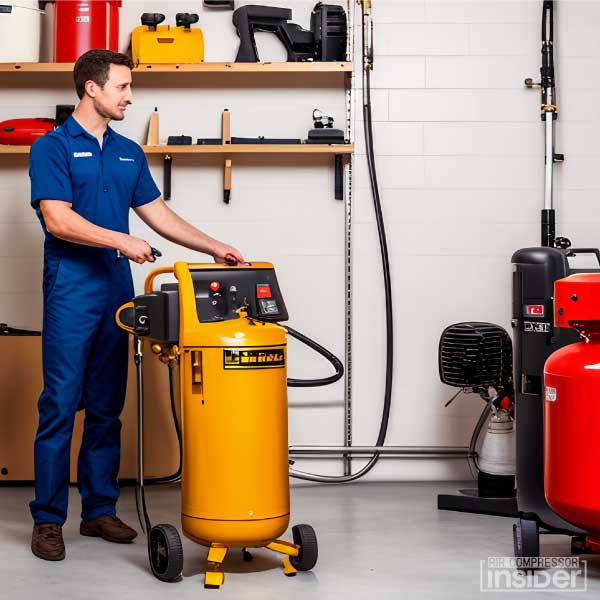
When choosing an air compressor tank size, several factors come into play.
1. Usage Requirements:
The type and frequency of tasks you plan to do with the air compressor significantly determine the size of the tank you should choose. If you use air tools that require high volumes of air for long durations, you’d need a larger tank.
2. Power Source:
Electric or gas-powered? Your power source might limit your options for tank sizes. While electric models are typically smaller and ideal for indoor use, gas-powered versions are larger and suitable for outdoor jobs.
3. Space:
The available space in your workplace or garage will also influence the size of the air compressor tank. Larger tanks require more room.
4. Portability:
If you move around frequently in your work, you might opt for a smaller, more portable tank.
5. Budget:
Larger air compressor tanks are generally more costly. Evaluate your needs and budget to make a balanced decision. Remember, a larger tank doesn’t always mean better.
It’s about finding the appropriate size that fits your specific needs.
How Big Of An Air Compressor Tank Do I Need?
The size of the air compressor tank you need depends on the type of work you intend to do. For light-duty tasks like inflating tires or powering small hand tools, or using a paint sprayer for small painting tasks, best 6 gallon air compressors would suffice.
However, for heavy-duty applications such as running air drills, sanders, or paint sprayers, you’d need a larger tank, ranging from 20 to 60 gallons or more.
Please remember these are just general guidelines; the specific requirements can vary based on the exact tools being used and their air consumption rate.
Always refer to your tool’s user manual to determine the proper air compressor size needed for optimal operation.
How To Fill Paintball Tank With Air Compressor?
Filling a paintball tank using an air compressor is a straightforward task if you follow these steps carefully:
Ensure Safety:
Before starting, make sure you’re wearing proper safety gear. This includes safety glasses and gloves.
Check the Tank’s Pressure Rating:
Identify the maximum pressure rating of your paintball tank (usually printed on the tank itself). Never attempt to fill the tank beyond this rating.
Connect the Tank to the Compressor:
Attach the paintball tank to your air compressor using a fill station. A fill station connects directly to the air compressor and has a quick-release valve and gauge to control the fill. Ensure that the connection is secure before proceeding.
Start the Air Compressor:
Turn on your air compressor and allow it to start filling the tank. Keep a close eye on the pressure gauge and stop filling once the desired pressure is reached.
Disconnect the Tank:
Once your tank is filled, shut off the air compressor and slowly release the quick disconnect to relieve the pressure between the fill station and the tank. Now, you can safely disconnect the tank from the compressor.
Remember, always follow safety guidelines when dealing with pressurized systems. If you are unsure or uncomfortable with any step, seek help or have a professional fill your tank instead.
How To Fill HPA Tank With Air Compressor?
Filling an HPA tank with an air compressor is a straightforward task, provided you follow some simple safety protocols.
Here’s how you do it:
Safety First:
Always make sure you’re wearing appropriate safety equipment, including safety glasses and gloves, before you start the filling process.
Connect the Tank:
Attach the air compressor’s hose to the tank’s fill valve. Make sure it’s a secure fit to avoid any leakages.
Begin Filling:
Slowly open the valve on your air compressor to begin filling the tank. Keep an eye on the pressure gauge to ensure you don’t overfill it.
Monitor the Process:
Pay close attention to the process as overfilling can result in a dangerous pressure build-up.
Finishing Up:
Once the tank has reached its capacity, close the valve on the air compressor and carefully remove the hose from the tank’s fill valve.
Remember, the exact steps may vary depending on the specific model of your air compressor and HPA tank.
Always reference the user manuals of your particular units for precise instructions.
How To Prevent HPA Tanks From Exploding?
To prevent High-Pressure Air (HPA) tanks from exploding, several safety measures must be observed.
1. Regular Inspection:
Regularly check the tank for any signs of damage or wear such as dents or rust. Consult a professional for inspection if you’re unsure about the condition of your tank.
2. Correct Handling:
Always handle the tanks with care to avoid any physical damage.
3. Store Properly:
Store the tanks in a cool and dry place, away from direct sunlight and heat sources to prevent pressure build-up.
4. Pressure Limits:
Never fill the tank beyond its rated pressure capacity. Exceeding this limit can cause the tank to explode.
5. Use Protective Gear:
Always use proper protective gear when handling HPA tanks. This includes safety goggles and gloves.
Taking these precautions will significantly reduce the risk of an explosion and ensure the safe use of HPA tanks.
How To Fill Co2 Tank With Air Compressor?
Filling a CO2 tank with an air compressor involves a sequence of steps which, when conducted safely and appropriately, can ensure your tank is ready for use.
1.Preparation:
First, ensure that your CO2 tank is completely empty. This can be achieved by attaching it to your CO2-using device (like a paintball gun) and allowing the remaining gas to be expelled.
2.Attach Adapter:
Securely attach a CGA 320 adapter to the air compressor. This adapter ensures that the pressure from the air compressor aligns with the CO2 tank.
3.Connect CO2 Tank:
With the adapter attached, connect your CO2 tank to the air compressor. Make sure all connections are secure to prevent any leaks during the refilling process.
4.Refilling:
Start the air compressor. As it runs, it will begin to fill the CO2 tank with compressed air. Watch the pressure gauge carefully, ensuring that the tank is not overfilled.
5.Finishing Up:
Once the tank is filled to the recommended PSI (usually around 800-1500), switch off the compressor and disconnect the CO2 tank. Your CO2 tank is now refilled and ready to use!
Remember, safety is paramount when refilling a CO2 tank. Always use gloves and protective eyewear, and perform the refilling process in a well-ventilated area.
How Many Gallon Air Compressor To Paint A Car?
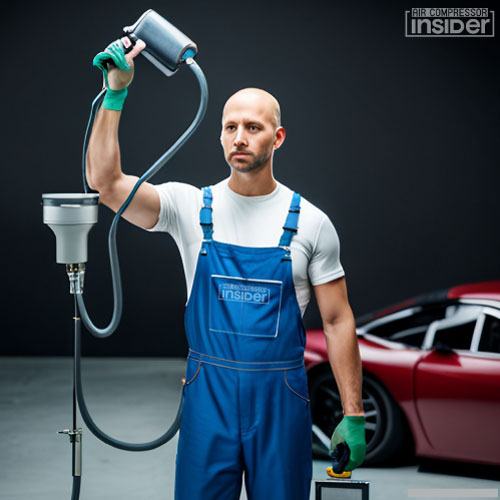
When it comes to painting a car, the size of the air compressor can significantly impact the end result.
Generally speaking, a 60-gallon air compressor with a minimum of 5-6 CFM (cubic feet per minute) at 90 PSI (pounds per square inch) is considered substantial enough to operate a spray gun and provide an even application of paint.
It’s also worth noting that features such as a high duty cycle, oil-lube pump, and a two-stage operation can enhance the performance of the air compressor and contribute to a more professional, high-quality paint job.
Remember, though, that every project is unique and may require adjustments based on factors such as the size of the car and the type of paint being used.
How Many Gallon Air Compressor To Blow Out Sprinklers?
The size of the air compressor needed to blow out sprinklers varies depending on the size and layout of the sprinkler system.
However, as a general rule of thumb, a compressor with a capacity of 20 to 30 gallons is typically sufficient for residential sprinkler systems.
This size allows the compressor to produce an airflow rate of 4 to 5 cubic feet per minute (CFM) at 50 pounds per square inch (PSI), which is adequate to clear out most standard sprinkler lines.
Nonetheless, it’s always advisable to consult with a professional or refer to the manufacturer’s instructions to determine the exact requirements for your specific system.
How Many Gallon Air Compressor Do I Need?
To determine the size of the air compressor you need, it’s essential to consider the type of tasks you plan to undertake.
For smaller tasks such as inflating tires or running nail guns, a 1-6-gallon air compressor should suffice.
However, for larger, more power-intensive tasks like running multiple air tools simultaneously or powering heavy machinery, you may require a larger air compressor of 60-80 gallons.
It’s always advisable to choose a compressor slightly larger than your estimated need to ensure optimal performance and longevity of the unit.
Does Air Compressor Tank Size Matter?
Yes, the size of an air compressor tank does matter and it impacts the performance based on the nature of the task it’s used for.
A larger tank holds more compressed air, which is beneficial for powering tools that require a continuous air supply, such as grinders or sanders.
Meanwhile, smaller tanks can refill more quickly and are ideally suited for intermittent uses, like nail guns or staplers.
However, it’s not just the tank size alone that determines the functionality. The compressor’s Cubic Feet per Minute (CFM) and Pounds per Square Inch (PSI) capability also play a significant role in its efficacy for various tasks.
What Are The Different Sizes Of Air Compressor Tanks?
Air compressor tanks come in a variety of sizes, typically measured in gallons, to accommodate different needs and applications.
Smaller Tanks:
Smaller tanks, ranging from 1 to 6 gallons, are portable and suitable for light tasks such as inflating tires or powering airbrushes.
Medium-sized Tanks:
Medium-sized tanks, which hold between 20 to 30 gallons, are ideal for powering most air tools and can be used for both home and commercial purposes.
Large Tanks:
Large tanks, with a capacity of 60 gallons or more, are designed for industrial applications and can support continuous, heavy-duty use.
The choice of an air compressor tank size depends on the nature and frequency of tasks it’s needed for, as well as the power requirements of the air tools being used.
What Is The Standard Size Of An Air Compressor?
The standard size of an air compressor can vary widely depending upon its intended use. For household tasks such as inflating tires or powering small tools, a compressor with a tank capacity of 1-6 gallons is typically sufficient.
For more demanding tasks, such as running large machinery or multiple tools simultaneously in an industrial setting, a larger air compressor with a tank capacity of 60-80 gallons may be required.
It’s essential to choose the appropriate size to ensure efficiency and longevity of your air compressor.
Please note that a larger size doesn’t always mean better; the right choice entirely depends on your specific needs and usage.
Air Compressor Sizing Excel:
The Air Compressor Sizing Excel is a beneficial tool designed to assist you in choosing the appropriate air compressor for your specific needs.
It takes into consideration various factors such as pressure, air flow rate, and usage patterns to determine the optimal size of the compressor.
This tool not only provides you with a precise sizing estimate but also aids in energy consumption analysis, thereby helping you to make an economical and efficient choice.
Understanding and utilizing this tool can lead to substantial cost savings and improved operational efficiency in the long run.
Air Compressor Tank Thickness:
The thickness of an air compressor tank is a crucial factor to consider as it directly impacts the durability, safety, and performance of the compressor.
Typically, tank thickness ranges from 2 to 16 mm, with the exact measurement depending on the tank’s size, the pressure it needs to withstand, and its intended use.
Heavier-duty industrial applications often require thicker tanks to handle higher pressure levels.
It’s essential to ensure that the tank meets the standards of Pressure Equipment Directive (PED) or American Society of Mechanical Engineers (ASME) for safety and performance.
Please consult with a professional or the manufacturer to select the appropriate tank thickness for your specific needs.
Air Compressor Tank Specification:
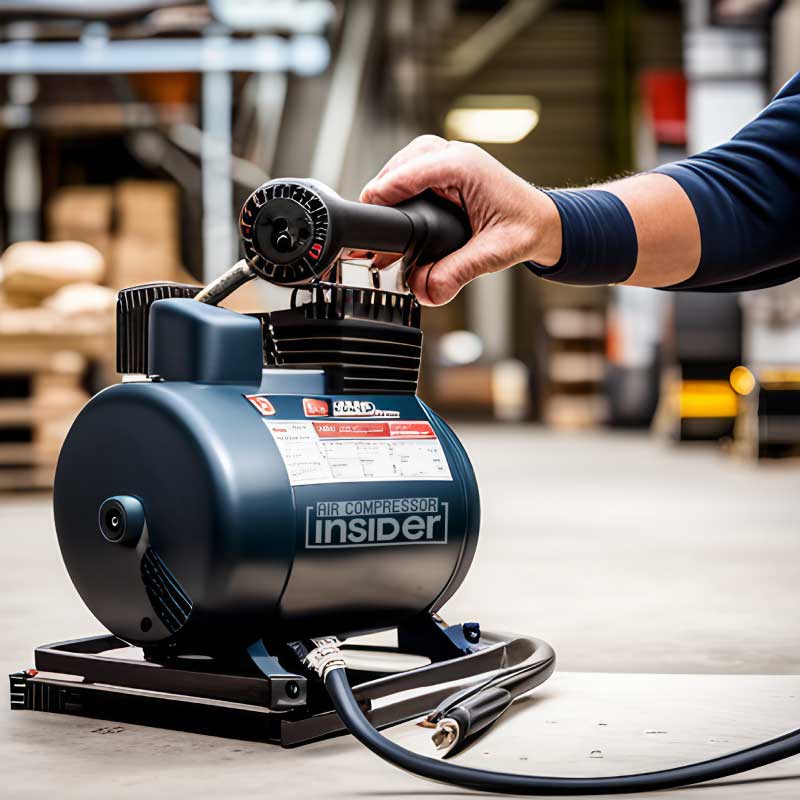
Air compressor tanks come in a variety of sizes and types, each designed to meet specific demands and applications.
The tank’s capacity, usually measured in gallons, directly influences the performance of the compressor.
Smaller tanks, ranging from 1 to 6 gallons, are portable and suited for small tasks such as inflating tires or powering nail guns.
Medium-sized tanks, from 20 to 30 gallons, are ideal for workshops and garages, powering tools such as spray guns and sandblasters.
Large tanks, upwards of 60 gallons, are stationary and used in industrial settings, providing continuous air supply for heavy-duty tools and machinery.
It is important to select a tank with the appropriate capacity to ensure optimal compressor performance and longevity.
Air Compressor Tank CFM Calculator:
CFM, or Cubic Feet per Minute, is an important measure when sizing an air compressor. It refers to the volume of air that the compressor can supply per minute.
The requirement for CFM can vary depending on the tools being used and the tasks being performed. To calculate CFM, you need to know the tank size and pressure.
The formula is: CFM = Tank Volume in Cubic Feet * Pressure (in psi) / 7.48.
Please note, this is a simplified formula and many factors can affect the actual CFM output such as compressor efficiency, altitude, and temperature. Always refer to the manufacturer’s specifications when possible.
How To Size An Air Compressor Tank
Sizing an air receiver tank is a crucial step in ensuring the efficiency and effectiveness of your compressed air system. To size an air receiver tank correctly, you must take into consideration several factors: the compressor’s capacity (measured in cubic feet per minute), the system’s demand pattern, and the duration of the peak demand.
The formula to calculate the suitable size in gallons is: V = T * (C – D) / P.
V is the volume of the tank, T is the time period during which the compressor is off, C is the compressor capacity, D is the demand of the system, and P is the atmospheric pressure.
For instance, if your air compressor has a capacity of 20 CFM, your system’s demand is consistent at 15 CFM, and the time during which the compressor is off is 2 minutes, the volume of the tank would be 2 * (20 – 15) / 14.7 (average atmospheric pressure at sea level), which is approximately 0.68 gallons.
Remember, this is a simplified calculation and there may be other considerations for your specific system’s needs. Always consult with a compressed air professional before making any decisions.
Air Compressor Tank Safety Guide:
1. Regular Inspections:
Ensure that your air compressor tank is routinely inspected. This includes checking for any visible signs of wear and tear, rust, or leaks.
2. Drain Moisture:
Make sure to drain any moisture collected in the air tank after each use to prevent rust and corrosion.
3. Proper Location:
Always store your air compressor in a clean, dry area to avoid exposure to dampness and extreme temperatures.
4. Avoid Overfilling:
Do not overfill the air compressor tank beyond its capacity. This increases the risk of a dangerous pressure-related incident.
5. Check Pressure Gauges:
Always monitor the pressure gauges and ensure they are functioning correctly.
6. Safety Valves:
Regularly examine safety valves for any signs of damage or malfunctioning.
7. Routine Maintenance:
Engage in regular maintenance as per the manufacturer’s specifications.
8. Professional Repair:
In case of serious issues, always seek professional assistance for repairs to maintain safety.
9. Use Proper Accessories:
Always use accessories that are compatible with your air compressor’s specifications.
10. Employee Training:
Ensure everyone who operates the air compressor has proper training in handling and safety procedures.
Air Compressor Tank Dimensions:
Air compressor tanks vary widely in capacity, usually expressed in gallons, and can range from small, portable units of 1 to 6 gallons, medium units of 7 to 30 gallons, all the way up to large stationary units which can hold 60 gallons or more.
The dimensions of the tank are dictated by its capacity, application, and design. Smaller tanks are typically cylindrical in shape and measure about 1-2 feet in length, while larger tanks can be up to 4-5 feet in length and are often either cylindrical or rectangular.
It is critical to choose your air compressor tank size based on the air tools you plan to use, and the duration and frequency of use.
Always remember, the larger the tank size, the longer your air tool can run. However, larger tanks also require more space and are heavier to move around.
Does Air Compressor Tank Size Matter?
Indeed, the size of an air compressor tank plays a significant role in its performance and suitability for different tasks.
A larger tank can store more compressed air at a higher pressure, which allows for longer use periods before the compressor motor has to kick back in to refill the tank.
This makes larger tanks ideal for prolonged, heavy-duty tasks. Conversely, smaller tanks tend to be more portable and cost-effective, making them suitable for light-duty tasks and intermittent use.
However, it’s important to note that tank size is just one aspect to consider when choosing an air compressor; other factors such as the compressor’s Cubic Feet per Minute (CFM) rating, power source, and maintenance requirements should also be taken into account to ensure you select the best compressor for your needs.
Can An Air Compressor Be Too Big?
Indeed, an air compressor can be too big for certain tasks and environments. When selecting an air compressor, size matters in a few key ways.
A larger air compressor will have a greater air capacity, which is beneficial for powering heavy-duty tools or for industrial applications.
However, it also requires more storage space and consumes more power, which can increase operational costs.
Furthermore, large air compressors may be overkill for light-duty tasks, leading to unnecessary energy consumption. Hence, it’s essential to consider your specific needs and usage scenarios while choosing an air compressor.
Benefits Of A Larger Tank:
A larger air compressor tank size brings with it several significant benefits that can enhance the efficiency and longevity of your operations.
Firstly, a larger tank has a greater storage capacity, ensuring consistent air pressure for longer periods and reducing the frequency of motor startups, thereby reducing wear and tear on the compressor.
Secondly, it allows for the operation of high-demand air tools or multiple tools concurrently, thus increasing productivity.
Lastly, the increased air volume in larger tanks aids in better condensation of moisture, reducing the risk of water entering your air tools and causing damage.
All these factors contribute to the improved performance and extended lifespan of your air compressor.
Benefits Of A Smaller Tank:
One of the key benefits of a smaller air compressor tank is its portability. Due to their compact size, these compressors are much easier to transport and maneuver, making them a convenient choice for mobile workshops or construction sites.
Another advantage lies in their operational efficiency. Smaller tanks often require less time to fill, meaning they can reach their maximum pressure more quickly.
This can lead to increased productivity, as less time is wasted waiting for the compressor to refill.
Additionally, smaller air compressor tanks tend to be less expensive and require less maintenance compared to their larger counterparts, making them a cost-effective solution for many users.
Is It Bad To Leave An Air Compressor Tank Full?
Leaving an air compressor tank full is not necessarily harmful if managed properly. However, it’s important to keep in mind that proper pressure maintenance and regular draining of the tank are crucial.
Over time, the compressed air can lead to the build-up of moisture inside the tank, which can cause rust and eventual structural deterioration.
Furthermore, if the compressor is subjected to extreme temperature fluctuations, the pressure inside the tank could increase dramatically, posing potential hazards.
Therefore, while it is not inherently bad to leave an air compressor tank full, it is essential to follow manufacturer’s guidelines for maintenance and safety to ensure the longevity of the device and prevent any potential risks.
Can A Pressure Tank Be Too Big?
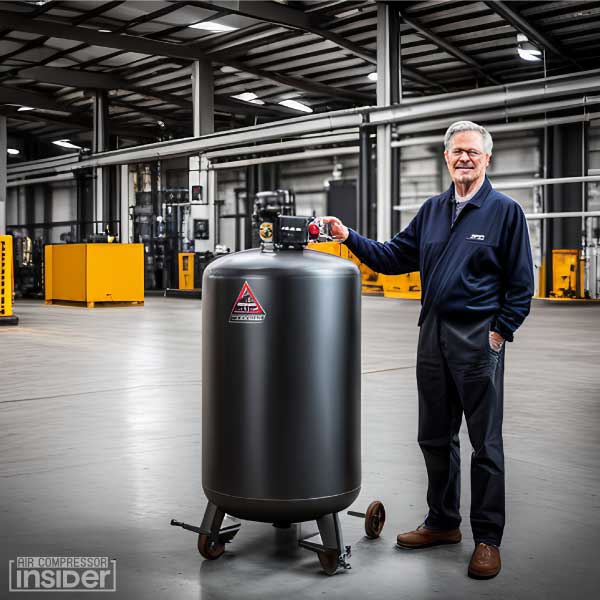
In theory, there’s no significant harm in having a pressure tank that’s larger than necessary. A larger tank doesn’t cause more water pressure, it simply holds more water.
In fact, a larger pressure tank can contribute to the efficiency of your system as the pump cycles less frequently, reducing wear and tear.
However, it’s essential to remember that a significantly larger pressure tank could be a waste of space and money, and it may be more challenging to install due to its size.
It’s always recommended to adhere to the manufacturer’s guidelines and work with a professional to select the appropriate tank size for your needs.
Is A Bigger Air Compressor Tank Better?
The answer to whether a bigger air compressor tank is better lies in the specific requirements of your application.
A larger tank undoubtedly holds more air, thus allowing for a longer duration of tool operation before the compressor motor needs to kick in again to refill it.
This can be crucial for tools that require a continuous air supply, such as a sandblaster or an air grinder.
However, a larger tank also means a larger, heavier, and potentially less portable unit. If your work involves light, intermittent use of pneumatic tools, a smaller compressor may suffice and offer the advantage of being easier to move and store.
Additionally, a bigger tank is generally more expensive and may consume more power, driving up your operating costs.
In essence, the “better” tank size for your air compressor depends largely on your work needs, the tools you’ll be using, and how frequently you’ll use them.
A professional consultation can help determine the optimal size for your specific circumstances.
How To Replace An Air Compressor Tank?
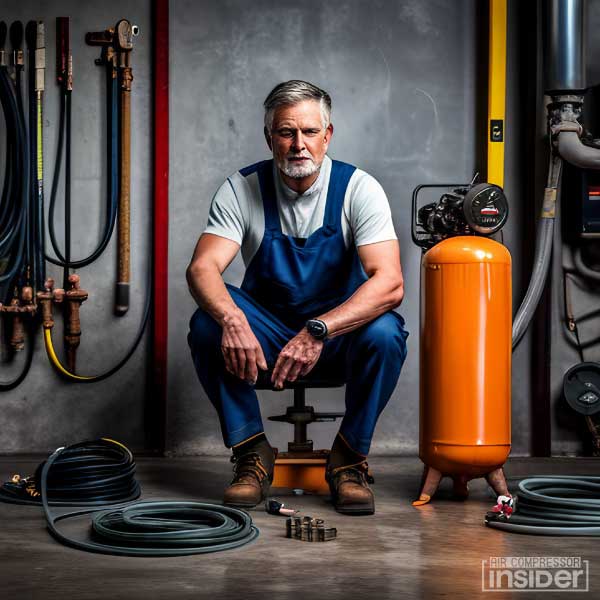
Replacing an air compressor tank can be an intimidating task, but it doesn’t have to be. Here are 10 easy steps to get the job done right:
1. Research the product you need:
It’s important to research the exact size and type of replacement tank your air compressor requires. Make sure you know what kind of valve connection your air compressor has as well.
2. Purchase the right replacement tank:
Once you’ve found the right air compressor tank for your unit, purchase it from a reputable source and make sure to check the product details carefully before buying.
3. Verify that you have all the necessary tools:
Before beginning, make sure you have all the needed tools like a screwdriver, wrench, and measuring tape.
4. Shut off the power:
Before proceeding, make sure to turn off the power to your air compressor and depressurize it by releasing any stored air inside.
5. Separate the tank from the unit:
Disconnect the old tank from your air compressor and remove all screws or bolts that may be holding it in place.
6. Install the new tank:
Carefully install the new air compressor tank, making sure you are using all of the correct mounting hardware and connections.
7. Secure the connection points:
Tighten any bolts or screws that connect the tank to your air compressor unit. Be careful not to over-tighten them as this could cause damage to both parts.
8. Test connections:
Prior to reconnecting power to your air compressor, turn the valve on the tank itself and check for leaks at all connection points.
9. Restore power:
Turn on your air compressor again and allow it to cycle through its start-up routine if necessary.
10. Final checks:
Check for any signs of wear or damage before proceeding with further use. Following these 10 steps should help you replace your air compressor tank with ease!
With the right tools and a bit of patience, you’ll have your machine running like new in no time. If you are ever unsure about any of the steps involved in replacing an air compressor tank, be sure to consult your unit’s manual or reach out to a professional for assistance.
Safety is always the top priority and it’s important to take all necessary precautions when working with power tools and air compressors.
Air Compressor Tank Design Calculation
When designing an air compressor tank, several critical parameters demand careful consideration.
The tank volume, dictated by the air compressor’s capacity, heavily influences the compressor’s overall performance.
To calculate this, we need to consider the compressor’s free air delivery (FAD) and the number of times the compressor cycles per hour.
Pressure rating is another vital element in the design calculation. This should match or exceed the maximum pressure of the compressor.
Moreover, it’s important to consider the material of construction, which needs to withstand the internal pressure, temperature variations, and any environmental factors.
Lastly, safety features like pressure relief valves must be factored into the design calculation to ensure the tank can handle any unexpected pressure buildup safely.
Remember, a poorly designed tank can lead to reduced efficiency, frequent maintenance issues, and potential safety risks.
Therefore, it’s crucial to perform thorough design calculations and consider every variable in the air compressor tank design process.
Frequently Asked Questions
Question #1
What are the different types of air compressor tanks?
There are mainly two types of air compressor tanks – single-stage and two-stage. Single-stage tanks are best for home and light commercial use, while two-stage tanks are designed for heavy-duty commercial use.
Question #2
How does tank size affect the performance of an air compressor?
The size of the tank directly affects the amount of air the compressor can store. A larger tank can store more air, allowing for longer periods of use before the compressor needs to kick in and refill the tank.
Question #3
What safety measures should be followed when using an air compressor tank?
Safety measures include regular inspection for leaks, keeping the compressor in a well-ventilated area to avoid overheating, and never exceeding the maximum pressure rating of the tank.
Question #4
How often should an air compressor tank be replaced?
The lifespan of an air compressor tank varies based on its use and maintenance. However, it should be replaced immediately if rust or other structural damage is detected.
Question #5
How to choose the right size of an air compressor tank?
The right size depends on the tools you’re using and the duration of their use. Larger tools or longer use require a larger tank.
Question #6
Can air compressor tanks explode?
While unlikely, air compressor tanks can explode if they’re not properly maintained or if the pressure exceeds the tank’s maximum limit.
Question #7
What is the difference between horizontal and vertical air compressor tanks?
The difference is purely in orientation and doesn’t affect performance. However, horizontal tanks may be easier to move, while vertical tanks take up less floor space.
Question #8
What material are air compressor tanks made of?
Air compressor tanks are typically made of steel for its durability and resistance to pressure.
Question #9
Can you use an air compressor tank for compressed natural gas (CNG)?
No, air compressor tanks are not built to handle the pressure of compressed natural gas and using them in this way could be dangerous.
Question #10
How to detect a leak in an air compressor tank?
The easiest way to detect a leak is by applying soapy water around the tank while it’s under pressure. If there’s a leak, bubbles will form.
